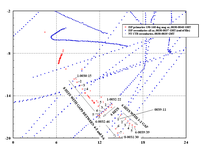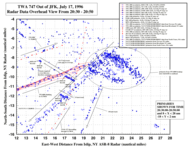
TWA Flight 800
Trans World Airlines Flight 800 (TWA800) was a Boeing 747-100 that exploded and crashed into the Atlantic Ocean near East Moriches, New York, on July 17, 1996, at approximately 8:31 p.m. EDT, 12 minutes after takeoff from John F. Kennedy International Airport, on a scheduled international passenger flight to Rome with a stopover in Paris.[1]: 1
"Flight 800" redirects here. For the 1964 crash in Rome, see TWA Flight 800 (1964). For the documentary, see TWA Flight 800 (film). For other incidents with the same flight number, see Flight 800 (disambiguation).Accident
July 17, 1996
In-flight breakup due to fuel tank explosion caused by short circuit
Atlantic Ocean, near East Moriches, New York, United States
40°39′N 72°38′W / 40.650°N 72.633°W
TW800
TWA800
TWA 800
N93119
John F. Kennedy Int'l Airport,
New York City, United States
Paris-Charles de Gaulle Airport,
Paris, France
Leonardo da Vinci Airport,
Rome, Italy
230
212
18
230
0
All 230 people on board died in the crash; it is the third-deadliest aviation accident in U.S. history. Accident investigators from the National Transportation Safety Board (NTSB) traveled to the scene, arriving the following morning[1]: 313 amid speculation that a terrorist attack was the cause of the crash.[2][3][4]
The Federal Bureau of Investigation (FBI) and New York Police Department Joint Terrorism Task Force (JTTF) initiated a parallel criminal investigation.[5] Sixteen months later, the JTTF announced that no evidence of a criminal act had been found and closed its active investigation.[6]
The four-year NTSB investigation concluded with the approval of the Aircraft Accident Report on August 23, 2000, ending the most extensive, complex, and costly air disaster investigation in U.S. history at that time.[7][8] The report's conclusion was that the probable cause of the accident was the explosion of flammable fuel vapors in the center fuel tank. Although it could not be determined with certainty, the likely ignition source was a short circuit.[1]: xvi Problems with the aircraft's wiring were found, including evidence of arcing in the fuel quantity indication system (FQIS) wiring that enters the tank. The FQIS on Flight 800 is known to have been malfunctioning; the captain remarked about "crazy" readings from the system about two minutes and 30 seconds before the aircraft exploded. As a result of the investigation, new requirements were developed for aircraft to prevent future fuel-tank explosions.[9]
On board TWA 800 were 230 people, including 18 crew and 20 off-duty employees,[21] most of whom were crew meant to cover the Paris-Rome leg of the flight. Seventeen of the 18 crew members[21] and 152 of the passengers were Americans; the remaining crew member was Italian, while the remaining passengers were of various other nationalities. Notable passengers included:[21]
In addition, 16 students and five adult chaperones from the French Club of the Montoursville Area High School in Pennsylvania were on board.[26][27]


